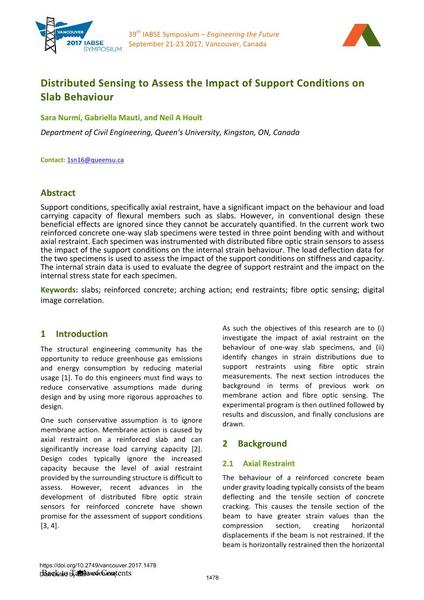Distributed Sensing to Assess the Impact of Support Conditions on Slab Behaviour

|
|
|||||||||||
Bibliographic Details
| Author(s): |
Sara Nurmi
(Department of Civil Engineering, Queen’s University, Kingston, ON, Canada)
Gabriella Mauti (Department of Civil Engineering, Queen’s University, Kingston, ON, Canada) Neil A. Hoult (Department of Civil Engineering, Queen’s University, Kingston, ON, Canada) |
||||
|---|---|---|---|---|---|
| Medium: | conference paper | ||||
| Language(s): | English | ||||
| Conference: | IABSE Symposium: Engineering the Future, Vancouver, Canada, 21-23 September 2017 | ||||
| Published in: | IABSE Symposium Vancouver 2017 | ||||
|
|||||
| Page(s): | 1478-1485 | ||||
| Total no. of pages: | 8 | ||||
| Year: | 2017 | ||||
| DOI: | 10.2749/vancouver.2017.1478 | ||||
| Abstract: |
Support conditions, specifically axial restraint, have a significant impact on the behaviour and load carrying capacity of flexural members such as slabs. However, in conventional design these beneficial effects are ignored since they cannot be accurately quantified. In the current work two reinforced concrete one-way slab specimens were tested in three point bending with and without axial restraint. Each specimen was instrumented with distributed fibre optic strain sensors to assess the impact of the support conditions on the internal strain behaviour. The load deflection data for the two specimens is used to assess the impact of the support conditions on stiffness and capacity. The internal strain data is used to evaluate the degree of support restraint and the impact on the internal stress state for each specimen. |
||||
| Keywords: |
slabs reinforced concrete end restraints digital image correlation arching action fibre optic sensing
|
||||
